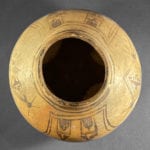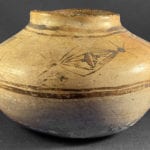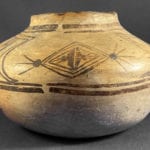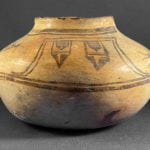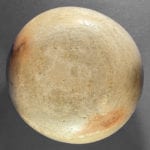The iconic Nampeyo pot is a Sikyatki Revival low-shouldered jar with her eagle-tail design. This collection contains such a pot (2005-16) dating from about 1905. So identified is this design with Nampeyo that the pot is recognizable as “by Nampeyo” from across a football field.
Pot 2019-05 was made about 15 years earlier than the Nampeyo jar and is “Polacca” ware that was the common style of Hopi and Hopi/Tewa pottery when Nampeyo was born about the middle of the 19th century. It is painted with a crude variant of the same eagle-tail design that Nampeyo used on seedjar 2005-16 and thus represents the design before Nampeyo standardized it.
The bottom of jar 2019-05 is somewhat thicker than its walls, but these are even and carefully formed. The jar has a short raised lip. The lip, one area of the shoulder, and one section of the bottom are blushed orange, indicating its outdoor firing. The surface of the jar carries a grey slip that has worn or flaked off in places but is only slightly crackled. Where the slip has been worn off (especially on the bottom) the clay body of the pot is revealed as very light tan.
On 2-14-19 I spoke with Ed Wade about this pot and he believes that pot 2019-05
“… dates to around 1890 owing to the brown black fugitive pigment…The vessels shape is a Polacca C. Looking closely one can see that the slip is slightly crazed….”
A thick-over-thin framing line encircles the base of the short neck. A thin-over-thick framing line encircles the jar’s waist, its widest point. Both sets of lines have spirit breaks. All of the design is between these framing lines.
The pot carries two designs, each repeated twice.
The eagle tail design:
The first is a crude representation of the eagle tail design and one rendition is quite dark, the second a bit more worn and thus lighter. The word “mesa” is Spanish for “table,” and this both describes the environment of Hopi villages and the basic structure of the eagle-tail design on this pot. The top of the “table” is a relatively straight line parallel to the upper framing lines. The table legs drop down from the top and curl outward as they reach the lower framing lines.
On the darker version of this design the table top is fairly flat and about 3″ long. The table form is repeated twice, one slightly larger and atop its mate so that there is a narrow but irregular gap between the two. The lighter second version of this form has a slightly concave top that is about 4″ long, but here the table shape is repeated twice below, giving the table thickness. For both the dark and light renditions, as the parallel legs curve outward they join and form a point.
Pendant from the underside of each table are two large arrow forms; in later renditions of this design they are usually described as “tails.” Each large arrow incorporates a smaller arrow in its base and the layout of the large and small arrows is the same. Of course I do not know the intention of the potter, but perhaps this is an attempt to show layered feathers, the smaller over the larger.
The base of the larger arrow is a large rectangle with its short end on the underside of the table. Inside this rectangle is a smaller arrow with a maroon rectangular base ending in a narrow, unpainted strip. At the center of this strip is a small unpainted triangle that hangs down into and bisects the black triangular head of the small arrow.
The large arrow then displays two parallel lines forming an unpainted strip that close off the rectangular base and from here the walls of the arrow slope inward to form a point. The lower of these parallel lines has a gap at its middle and from it hangs an unpainted narrow triangle that bisects the larger triangular black arrow head. The large right arrow in the lighter eagle tail design is a bit different. Here the lower strip of the unpainted section at the base of the head is a relatively wide triangle with a smaller narrow triangle extending from its peak: a two-stage triangle. Of the four renditions of these large arrow forms, some are painted more carefully than others.
The visual contrast between the linear tails and the curved wings adds energy to the otherwise rather staid design, a design strategy later adopted by Nampeyo (Appendix B).
The lozenge design:
The second design is built around a large lozenge form about 2.25″ long and composed of three increasingly smaller such forms nested within one another. Here again one version of this design is darker than the other, though both have exactly the same elements. The worn example, however, is not a carefully drawn as the darker.
On the lateral tips of the design on jar 2019-05 are painted a small black ball and emanating from this ball is a fan of straight lines. The darker version of this design has 3 lines fanning out from one end, 5 from the other. The lighter second rendition has 4 lines from each end, though these are arranged somewhat differently. This design is interpreted by Alexander Steven as a prayer offering or “paho” (Patterson, 1994:201). For another Polacca example of this ball and lines, see Wade and McChesney (1981:65, pot 43-39-10/24781).
Central and internal to the lozenge is an element that looks somewhat like a coffee bean. It is formed by two shallow hill-shaped elements with parallel bases. The left hill is painted maroon, the right black. Aexander Steven believed these to be split cloud images, “naktci” (Patterson, 1994:141). Attached to the apex of each hill is another round ball with three emergent lines.
Lozenges elements were found on Jeddito black-on-yellow ware at at Awatovi and date from 1300 CE to 1600 CE (Moulard, 2002:Plate 86,143-144 and 169). The lozenge element was also common on jars and the exterior of bowls during the production of Polacca “C” ware, 1860 to 1890 (Wade and McChesney, 1981:382-383 and 594).
A photograph of pot 2019-05 is published in Wade and Cooke,2022:79.
A history of the eagle-tail design:
What we call the “eagle-tail design” has prehistoric precedence. Between about 1500 and the 1580’s, the village of Kawaika-a was inhabited by Hopi people on Antelope Mesa, Arizona (Smith, 1952:29, FN92). In the 1930’s the ruins of this village and the nearby site of Awatovi were excavated by a team of archeologists from Harvard’s Peabody Museum. A great deal of pottery was recovered, much of it Sikyatki Polychrome. Watson Smith illustrates three different Sikyatki bowls from Kawaika-a with interiors painted with variations of the eagle-tail design (1952:176-177, Figure 10, p, q and r). The design on the last of these vessels became the monogram of The Museum of Northern Arizona. Steve Elmore published photographs of three additional Sikyatki bowls that are part of the Keam Collection at the Peabody Museum and display rather crude versions of the eagle-tail design (2015: 166, 169 and 170).
After the Spanish conquest of the southwest in the 1540’s, the Native Jeddito and Sikyatki traditions ended at Hopi, and San Bernardo (1625 to 1740) and Payupki (1680 to 1780) styles became the characteristic Hopi pottery types. These gave way to Polacca Polychrome pots that characterized Hopi pottery style for the next 120 years, about 1780 to about 1900.
In a phone conversation on 3-5-19, I asked Ed Wade about the history of the eagle-tail design. He replied:
“The eagle tail is an old Sikyatki design that was lost when the San Bernardo and Payupki styles became the dominant Hopi designs. About 1850 you begin to see variations of the eagle tail reintroduced on Placcaware pottery. Most probably the older Sikyatki designs were rediscovered by Hopi men cleaning out the springs at Sikyatki or near First Mesa, in much the same way that Nampeyo rediscovered Sikyatki design a generation later.
The Kentucky Historical Society has an early Polacca eagle tail collected in the 1870’s and donated to the museum in 1879. In 1883 John Wesley Powell collected a large number of pots at Hopi, numbers of them with the eagle-tail design. Both incurving and reversal wings were drawn on these pots, with probably the majority reversal, as on your jar.”
I find three published examples of Hopi/Tewa pots displaying an eagle tail designs with out-curving (“reversal”) eagle wings, as on pot 2019-05. All are part of the Cooke Collection, now at the Museum of the West in Scottsdale, Az (Wade and Cooke, 2012:100-101, 154-155 and 168-171) and all are attributed to Nampeyo. Only one is Polacca ware, dating from about 1885-1890. This jar is much more carefully painted than 2019-05. The design is a very simplified version of the eagle-tail design later drawn by Nampeyo on Sikyatki Revival pottery. The other two pots have their designs “floated” on the orange blushed surface of the pot. One is a large black-on-yellow jar dating from about 1900 and also probably by Nampeyo. On this jar the eagle-tail design is repeated twice and the out-curving feathers curve around the jar’s circumference and almost meet on the jar’s sides, a visually compelling motif. The second is a very large jar with red swags hung from the tips of adjoining renditions of the out-curved tails and is dated ca 1907.. I played some part in identifying this jar as “by Nampeyo” and Rachael Shamie reproduced this jar for me using diagnostic photographs I had taken in the original owner’s home. (See 2007-17.)
I can find 6 other published example of Polacca ware with variations of the eagle-tail design, but all have incurving tails, unlike pot 2019-05. All are part of the Keam Collection in the Peabody Museum and all are published in Wade and McChesney. Five are from First Mesa (1981: 457, 458, 459, 461 and 520). A 6th pot with a cruder variant of the eagle tail is believed to be the product of Mishongnovi village (1981:85). The expanded view of the design on one of these jars (Peabody catalog number 43-39-10/25140) was used as the cover of Wade and McChesney’s study Historic Hopi Ceramics (1981) and the pot also picture in their exhibit catalog America’s Great Lost Expedition (1980:98). All of these photographs are black-and-white. Another eagle-tail pot was shown in both of these volumes (Peabody catalog number 43-39-10/25813) and then printed in color by Elmore (2015:184). The five First Mesa pots are typed as Polacca style “D,” which was produced for about 10 years, 1890 to 1900. (Wade and McChesney, 1981:455).
In summary, 2019-05 is an historic example of the eagle-tail design rooted in the creativity of prehistoric potters. The rediscovery of this design in the 19th century is the first “Sikyatki Revival” preceding the revival credited to Nampeyo by at least 10 or so years. Nampeyo was a young woman when pot 2019-05 was made. She learned the eagle-tail design from Polacca pots like this. Indeed, exposure to the linear vs curvilinear tension in this design was a strategy that she adopted into her mature style a decade later. Thus pot 2019-05 is not only a revival of an ancient design, but a harbinger of greatness.


